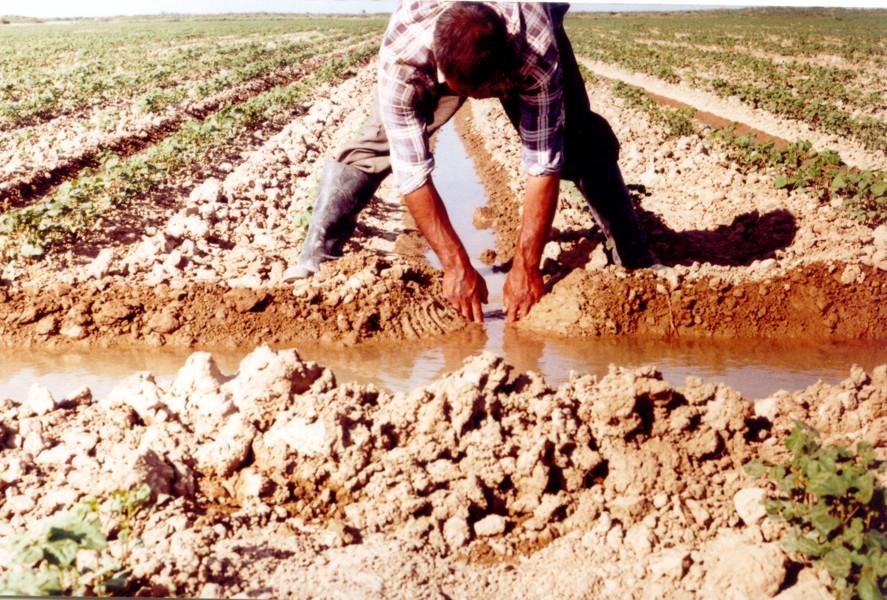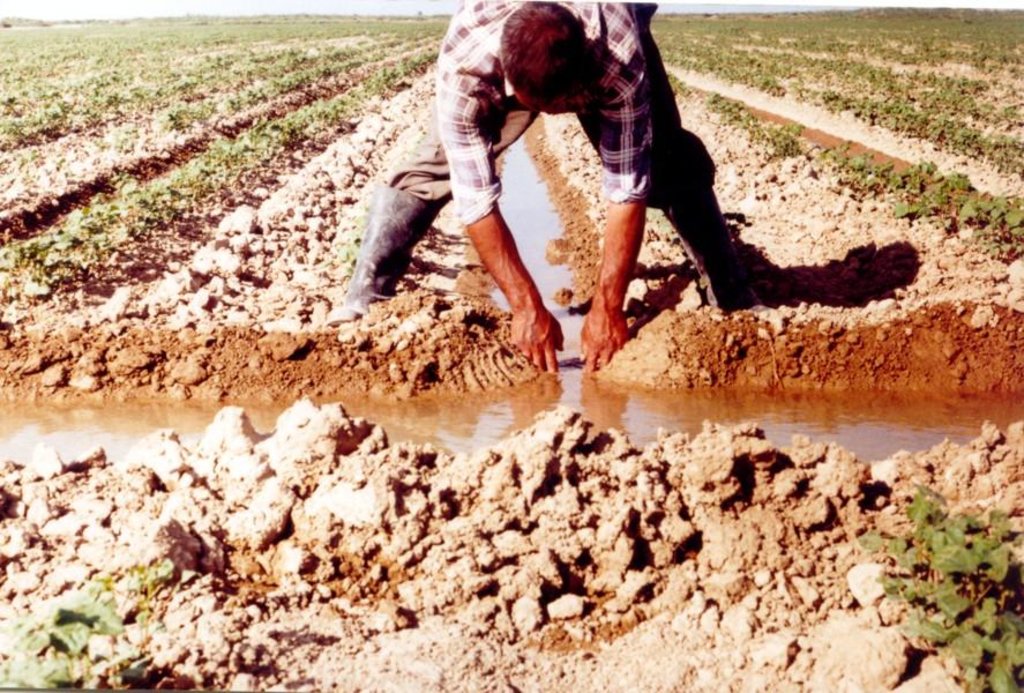Watering through furrow [Kazakhstan]
- Creation:
- Update:
- Compiler: Unknown User
- Editor: –
- Reviewer: Fabian Ottiger
approaches_2364 - Kazakhstan
View sections
Expand all Collapse all1. General information
1.2 Contact details of resource persons and institutions involved in the assessment and documentation of the Approach
Key resource person(s)
SLM specialist:
Vyshepolskey Franc
2-47-78,
Kniv@nursat.kz
SRI for Water Management
12 Koigeldy str Jambul area, Taraz city 484022
Kazakhstan
1.3 Conditions regarding the use of data documented through WOCAT
The compiler and key resource person(s) accept the conditions regarding the use of data documented through WOCAT:
Yes
1.4 Reference(s) to Questionnaire(s) on SLM Technologies

Water-conservation technology at cultivation of the cotton in … [Kazakhstan]
The technology of watering through furrow reduces the settlement (recommended) sizes of irrigating norms up to 30% keeps soil fertility
- Compiler: Unknown User
2. Description of the SLM Approach
2.1 Short description of the Approach
Watering through furrow
2.2 Detailed description of the Approach
Detailed description of the Approach:
Aims / objectives: To the developing of irrigated agriculture in a valley of the river Syr-Darya is interfered the deficiency of water resources. The problem of stabilization of an agricultural production is solved due to using of the SWC approach 'watering through furrow'.
Methods: The approach provides a necessary level of accumulation of a moisture into the soils for reception of guaranteed crops. Water supply is carried out by means of watering through furrow on a farmlands from conditions of saturation of 1.5 meter layer up to a field moisture capacity. At absence of financing for reconstruction of irrigating system the water availability of the irrigated soils raises due to optimization of the watering elements. For this purpose on an irrigated field are laying furrows long 150-400 m., the distances between furrow can change from 0.7 up to 0.9 meter. Width of a furrow on top 35-40 sm., and depth from 12 up to 17 sm., depending on slope of surfaces of the ground. Experience shows that the effect of uniformity of humidifying of ground is reached at the consumption of water of 0.9 liter/sec (quantity of absorbing water in the end of furrow to absorbed volume in head). Depending on agromeliorative properties of soil, can vary from 1.1 up to 0.7 liter/sec. In view of control of a water stream at watering through furrow, make a reinforcing of headstalls of irrigating furrows by cellophane napkins (50*50sm), irrigation tubes. Watering through furrow allows to reduce the losses of water to a filtration in 2 times, on dump and evaporation in 1.5 times. Due to reduction of these losses it is possible to improve water-availability of other irrigated masses on 20-30%. The given approach allows to save water resources to apply widely technique, provides high germination and survival of cultivated cultures, and save a manpower. The soil-cultivating technique passes on dry furrow and provides high quality of interrow cultivating of soils. The waterier easily moves on a field (dry furrows) and carries out duly redistribution of water in furrows, that improves quality of watering, operating conditions of a drainage, raises uniformity of humidifying soils, reduces expanses of water for reception of unit of agricultural production.
2.3 Photos of the Approach
2.5 Country/ region/ locations where the Approach has been applied
Country:
Kazakhstan
Region/ State/ Province:
Southern-Kazakhstan
2.6 Dates of initiation and termination of the Approach
Indicate year of initiation:
2000
2.7 Type of Approach
- traditional/ indigenous
2.8 Main aims/ objectives of the Approach
The Approach focused on SLM only (Conjoining of humus horizone, deficiency of water, heavy loams, secondary salinization, filtration)
Water resources management and optimization of the watering superficial technologies of the irrigated grounds.
The SLM Approach addressed the following problems: 1. Water conservation 2. Maintenance of guaranteed crops
2.9 Conditions enabling or hindering implementation of the Technology/ Technologies applied under the Approach
availability/ access to financial resources and services
- hindering
Lack of mean for reconstraction of irrigating system
Treatment through the SLM Approach: Introduction of the SWC technologies
institutional setting
- hindering
Absense of essential measures on water-division
Treatment through the SLM Approach: There are created the Regional structures-BWA (Basin Water Associations)
3. Participation and roles of stakeholders involved
3.1 Stakeholders involved in the Approach and their roles
- local land users/ local communities
Working land users were mainly men (Proprietors on the ground are basically men), Having small plots of the graunds (till 1 ha)
- international organization
farms associations
3.2 Involvement of local land users/ local communities in the different phases of the Approach
| Involvement of local land users/ local communities | Specify who was involved and describe activities | |
|---|---|---|
| initiation/ motivation | none | |
| planning | passive | public meetings, interviews/questionnaires |
| implementation | passive | responsibility for minor steps; anxiety for the plots and for the future income |
| monitoring/ evaluation | none | |
| Research | none |
3.4 Decision-making on the selection of SLM Technology/ Technologies
Specify who decided on the selection of the Technology/ Technologies to be implemented:
- mainly SLM specialists, following consultation with land users
Explain:
The initiative of expertsof SRI (Scientific Research Institute)
Decisions on the method of implementing the SLM Technology were made by by SLM specialists alone (top-down). Development of the SWC land users
4. Technical support, capacity building, and knowledge management
4.1 Capacity building/ training
Was training provided to land users/ other stakeholders?
Yes
Specify who was trained:
- land users
- politicians/decision makers
Form of training:
- on-the-job
- farmer-to-farmer
Subjects covered:
Geology, soil scince, ecological hydrology
4.2 Advisory service
Do land users have access to an advisory service?
Yes
Describe/ comments:
Advisory service is very adequate to ensure the continuation of land conservation activities; SRI has the qualified professionals carable to create service of training on places (farms)
4.3 Institution strengthening (organizational development)
Have institutions been established or strengthened through the Approach?
- yes, moderately
Specify the level(s) at which institutions have been strengthened or established:
- local
Specify type of support:
- capacity building/ training
4.4 Monitoring and evaluation
Is monitoring and evaluation part of the Approach?
Yes
Comments:
bio-physical aspects were ad hoc monitored through measurements
economic / production aspects were ad hoc monitored through observations
There were several changes in the Approach as a result of monitoring and evaluation: Ther were developed some approaches of management of a water stream in irrigating furrow by means of reinforcing its heads (cellophane napkins, irrigation tubes, siphons)
4.5 Research
Was research part of the Approach?
Yes
Specify topics:
- ecology
- technology
Give further details and indicate who did the research:
For the varius types of soil there were developed the norms of watering, a mode of an irrigation of adricultural crops and optimization of technologies of superfisial watering
Research was carried out on-farm
5. Financing and external material support
5.1 Annual budget for the SLM component of the Approach
If precise annual budget is not known, indicate range:
- < 2,000
Comments (e.g. main sources of funding/ major donors):
Approach costs were met by the following donors: government (national - Kazakhstan SRI): 95.0%; local community / land user(s) (Akimat): 3.0%; other (Separate farmers): 2.0%
5.2 Financial/ material support provided to land users
Did land users receive financial/ material support for implementing the Technology/ Technologies?
Yes
5.3 Subsidies for specific inputs (including labour)
- equipment
| Specify which inputs were subsidised | To which extent | Specify subsidies |
|---|---|---|
| machinery | partly financed | |
| irrigation net | partly financed | |
If labour by land users was a substantial input, was it:
- voluntary
Comments:
Interest of farms in reception of guaranteed crops
5.4 Credit
Was credit provided under the Approach for SLM activities?
No
6. Impact analysis and concluding statements
6.1 Impacts of the Approach
Did the Approach help land users to implement and maintain SLM Technologies?
- No
- Yes, little
- Yes, moderately
- Yes, greatly
The approach of watering through furrow, and also techniques on management of a water stream in furrows (film, napkins, tubes)
Did the Approach improve issues of land tenure/ user rights that hindered implementation of SLM Technologies?
- No
- Yes, little
- Yes, moderately
- Yes, greatly
Did other land users / projects adopt the Approach?
- No
- Yes, little
- Yes, moderately
- Yes, greatly
State SPC, the Ministry of Agriculture recommends self-covernment institutions, coommittees of a Water Management and Agriculture to use developed by the SWC approach the norms of irrigating and applications of ways of reinforcing of irrigation furrows
6.3 Sustainability of Approach activities
Can the land users sustain what has been implemented through the Approach (without external support)?
- yes
6.4 Strengths/ advantages of the Approach
| Strengths/ advantages/ opportunities in the land user’s view |
|---|
| Opportunity of application of the SWC approach on various types of soil with a mode of humidifying (How to sustain/ enhance this strength: To give an explication of the soil as humidifying) |
| To duplicate (to expand) application of the SWC approach (How to sustain/ enhance this strength: To raise grants possibility) |
| Strengths/ advantages/ opportunities in the compiler’s or other key resource person’s view |
|---|
| Loses of water to a filtration are reduced (How to sustain/ enhance this strength: Improvement of technologies of superficial irrigation) |
| Saves water consumption (How to sustain/ enhance this strength: Expansion of an area of application of the SWC approach) |
| Improves well-being of local population (How to sustain/ enhance this strength: Propagation of the SWC approach and training of farmers) |
6.5 Weaknesses/ disadvantages of the Approach and ways of overcoming them
| Weaknesses/ disadvantages/ risks in the compiler’s or other key resource person’s view | How can they be overcome? |
|---|---|
| The account of a slope of surface of allotments is insufficiently fulfilled | Creation of the maps of land using with the indicatin of a slope of surface |
7. References and links
7.1 Methods/ sources of information
- field visits, field surveys
- interviews with land users
Links and modules
Expand all Collapse allLinks

Water-conservation technology at cultivation of the cotton in … [Kazakhstan]
The technology of watering through furrow reduces the settlement (recommended) sizes of irrigating norms up to 30% keeps soil fertility
- Compiler: Unknown User
Modules
No modules





